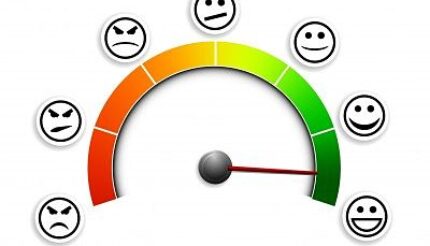If you had a headache, you might take a paracetamol. But what would happen if you only took 1/16th of a tablet? Not a lot – it wouldn’t touch the sides. I think you can look at marketing the same way and ask the question: what’s the minimum effective dose when it comes to marketing activities?
What would happen if you went to one networking event a year? Or sent one annual email newsletter; posted once on LinkedIn? Clearly, twice the square root of sod-all.
When ‘doing’ marketing, you’ll need to find out what the minimum effective dose is. Enough to create a pipeline and get a return on investment of your time, expertise and budget.
If you’re not sure, you’re probably doing too little
If the TV programme QI monitored posts from business coaches, the alarm would sound whenever the Pareto Effect* was mentioned – but bear with me.
The Pareto Effect is essentially a catch-all way to describe the type of uneven distribution seen in pretty much every facet of business. Such as your largest customers providing the majority of your revenue; or your top salespeople bringing in the bulk of new business – and it’s the same with results from any particular marketing channel.
Of all the people who are engaging in a marketing channel, the minority will be getting the majority of the spoils available.
This is because most people take an average or below-average approach – and in the great game of business you don’t tend to get rewarded for average.
The people doing 95% and above of best practice will divi-up the bulk of the returns. The rest will – to a variety of degrees – be wasting their time, effort and money.
They’re taking 1/16th of a paracetamol to cure their marketing headache.
And a very few of you might be doing too much
Nick Jenkins of Moonpig fame was on our podcast a few months back and it should be required viewing for anyone who wants to get their marketing working better. In a nutshell: marketing is maths.
He was religious in his desire to measure the efficacy of any marketing channel. He knew exactly how much he was prepared to pay for an enquiry (based on Conversion Rate, Repeat Business and Gross Profits) and tried any and every marketing channel to see which ones produced the goods.
(Spoiler alert: Moonpig were struggling to make ends meet until he tried TV advertising – then they went to the, er, moon.)
One of the interesting points to emerge was that every channel seemed to have a ‘sweet spot’. A point beyond which increased budget and effort stopped producing proportionate increases in output. One specific channel he referenced for this was PPC advertising.
What is the minimum effective dose for marketing?
Broadly speaking, the clue to this is actually in the podcast with Nick Jenkins.
To paraphrase him: It’s much easier to teach a mathematician how to be a marketer than it is to teach a marketer mathematics.
His point is pretty clear: the only true benchmark of marketing success is RoI. You can get involved in as many LinkedIn debates as you like about whether tele-marketing / cold email / direct mail etc etc still work – the only truth lies in what works.
Test & measure like you mean it.
The best first step for this is to calculate the Average Cost Per Lead from each channel – and then to track it. As long as that number is tracking down keep asking the 3 big questions:
Who is doing this better than us and what can we learn from them?
How do we refine and improve our approach?
Can we scale it up?
How to stand out in a crowded marketplace?
I sometimes wonder what proportion of people posting on social media actually make money out of it? Where they get a quantifiable return on investment from their time, effort and budget.
My guess is that the Pareto effect is in full working order here: that 80% of active users are generating next to nothing.
I’ll share a thought from 2 of our speakers at Biz-X 2025 the other week which may help.
Gary Vaynerchuk on Minimum Effective Dose
Gary V (unexpectedly likeable and charming to boot) made the point that for the time being social media is free – and, thanks to the AI-enhanced algorithm, a total meritocracy. If your post is valuable, it will be made visible.
If you’re an expert and are prepared to share authentically and regularly you can and will get traction for your business.
What counts as authentic? Video.
What counts are regularly? Once per day on LinkedIn, more on Insta & Facebook.
I guess that idea fills you with horror – it does me. He was asked (challenged!) on this point: surely this would irritate your audience to the point of actively disengaging?
His response was nuanced: maybe there is such a thing as too much and maybe ‘too much’ is lower in the UK than the US – but if they’re disengaging they were never likely to buy. And ultimately, you’ll miss out on far more because your prospects are buying from your competition than because people are disengaging.
On balance, pretty much everyone in the UK is nowhere near that level and needs to do more than they currently are.
Daniel Priestley on Standing out in a Crowded Marketplace
I’d just watched the DOAC podcast with Daniel and (vs) Gary Stevenson hosted (refereed) by Steven Bartlett and had high hopes – and was in no way disappointed.
His argument was that we all have a finite and relatively small number of memory slots for businesses (not including brands). And we all have a filter to ensure that forgettable people are not remembered.
[The data on this is not precise for a variety of quite long-winded reasons. Feel free to follow me down the rabbit hole and learn all about Dunbar Numbers (a scientific study into capacity to remember names) but it’s somewhere around 150].
For someone to get through this filter they have to be one or more of 5 things: Scary, Sexy, Strange, Valuable or Familiar. (I’d watch that Snow White remake to be fair).
I’m going to go ahead and admit that my chances of being any of the first 3 are slim. There may well be people who have thought I’m strange and who knows, even scary – but not in a way that can be monetised for my business.
Not wanting to drag you down to my level, but if you’re also aiming to major on numbers 4 & 5, his research shows that the average (B2B) prospect consumes 7 hours of content over 11 interactions before making contact.
This begs 2 important questions of you:
First, at your current pace of content creation, how long will it take someone to rack up those 7 / 11 numbers?
Second, is your content actually valuable? The Priestley gold standard for this is whether someone would pay for it.
As a side note: What’s the ideal number of marketing channels?
This is one of those ‘how long is bit of string’ questions.
The larger the business the more reliable, profitable marketing channels you need. It spreads the load and the risk.
The absolute ideal would be 10 x 10. In other words, 10 great marketing channels each contributing 10% of your new business.
Clearly this is easier said than done – I’ve yet to achieve it with any of my clients – but it a goal that will take your business in the right direction.
At the other end of the scale, if you’re turning over more than £1m with fewer than 5 profitable marketing channels, you’ll want to get this onto you strategic priority list.
In conclusion
I’ve been writing this article whilst heroically trying to avoid using the phrase ‘half-a***d’ – but I can’t do it.
I’d never want to be pointlessly provocative, but it sums up so precisely and evocatively the approach of many businesses towards most marketing channels.
You see this type of thing frequently:
Having an SEO guy but missing the deadlines for content.
Allocating a PPC budget but not making the time to analyse the numbers, split A:B test and refine.
Going to a trade show without a rock-solid system to collect, follow up on and nurture leads.
These are all incredibly easy to do, and maybe you get away with it in times of plenty.
But if you’ve got serious growth ambitions – especially if that involves selling your business – you’ll want to reach for better.
If you want a marketing channel to really work you’ll need to be in the top 5% when it comes to best practice.
Best regards,
Tim
P.S. If you’d like to look at this seriously, get yourself booked in for a complimentary marketing review:
- Book a Marketing Review zoom call
- Ask for a call-back
- Take my business self-assessment test
- WhatsApp 07825 589333





